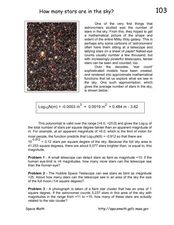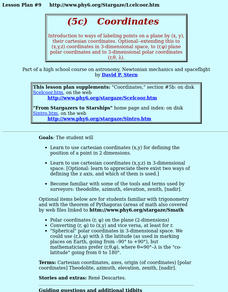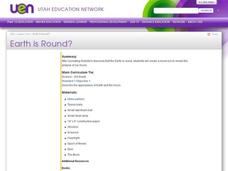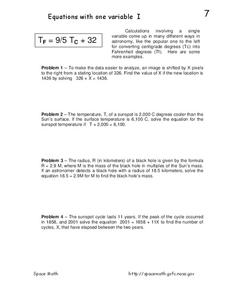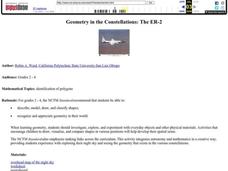NASA
Exploring Exoplanets with Kepler
Calculate the movement and properties of planets like professional astronomers! Scholars use Kepler's third law to find Mercury and Venus's distance from the sun. Using changes in brightness of distant stars and Kepler's third law,...
Curated OER
Fractions, Decimals, and Gravity
Young scholars discuss how weight is directly related to gravitational force on a planet. Students then choose Space Traveler as companion and compute how much their guide weighs on various planets, based on each planet's relative...
Curated OER
Variables and Expressions from Around the Cosmos
In this variables and expressions worksheet, students solve 7 problems using different mathematical formulae to find the length of Earth's day in the future, the distance to the galaxy Andromeda, the temperature of a gas cloud emitting...
Curated OER
How Many Stars are in the Sky?
In this star count worksheet, students solve three problems using a given polynomial and its logarithm to determine the number of stars in a given area.
Curated OER
Our Solar System to Scale
Students calculate the diameter of planets and their relative distances. For this space science lesson, students discover how small or big the planets are in comparison to each other. Students use cross multiplying fractions to find the...
Curated OER
Coordinates
Students use cartesian coordinates (x,y,z) in 3-dimensional space. [Optional: appreciate there exist two ways of defining the z axis, and which of them is used.] They become familiar with the tools and terms used by surveyors.
Curated OER
The Big Bang Theory
Young scholars will use scientific reasoning to formulate ideas about the formation of the universe using the Big Bang Theory. The use of critical thinking skills is part of the activity and the foundation of the scientific method will...
Curated OER
The Solar Cycle
Learners research the solar cycle. In this Science lesson, students use the internet to investigate the solar cycle. Learners produce a spreadsheet and graph from the information collected.
Curated OER
Teachers' Notes: Switch Gets Ready!
Students practice multiplication facts, answer simple math questions from two, five, and ten times-tables, explore concept of halves and quarters, complete worksheet containing range of shapes to make shape picture, and sort data and...
EngageNY
Choice of Unit
Explore using units with scientific notation to communicate numbers effectively. Individuals choose appropriate units to express numbers in a real-life situation. For this 13th lesson of 15, participants convert numbers in scientific...
Curated OER
Lotto or Life: What Are the Chances?
Though the website does not seem to have the mentioned video, a reding and lottery style games simulate the chances of finding intelligent life somewhere other than Earth. Without the video, this instructional activity is short, but it...
Curated OER
Flying with Pythagoras
A lengthy narrative about Pythagoras and his students precedes an activity in which your young mathematicians practice using the Pythagorean theorem to solve three problems about flight and distance. Answers are provided.
Curated OER
Calculating Arc Lengths of Simple Functions-I
In this calculating arc lengths worksheet, students are given 4 simple functions and they use the Pythagorean Theorem and the basic techniques of calculus to find the arc-length formula in order to find the arc-length.
Curated OER
Earth is Round?
Third graders discuss how Aristotle concluded that the Earth was round. As a class, they review theories about the Earth's shape and describe how life on Earth would be different if it were flat. Individually, they make a moon book in...
Curated OER
Equations with one Variable
In this algebra worksheet, students solve word problems by rewriting it as an equations and solving for the unknown. There are 4 questions with an answer key.
Curated OER
Equations with one Variable II
In this single variable equations worksheet, students solve 5 problems using different equations to solve for one unknown. They use Hubble's Law to find the velocity of a galaxy knowing the distance it travels.
Curated OER
Exploring The Neighborhood of the Solar System
Young scholars explain why exploring the universe for life on other planets is an important field of study. They use mathematical formulas to calculate the temperatures of planets as it relates to their distance from the sun. Students...
Curated OER
The Night Sky
Third graders develop questions they have about the solar system. After being read a book, they view and discuss different constellations in the sky. In groups, they are given a piece of butcher paper and glow in the dark crayons in...
Curated OER
2 Digit Subtraction Worksheets with Regrouping
In these subtraction worksheets, students will subtract single and double digit subtrahends from double digit minuends. Students will need to regroup to solve.
Curated OER
Evaluating Secondary Physical Constants
In this physical constants worksheet, students use fundamental physical constants of nature to determine "secondary" constants. This worksheet has 7 problems to solve.
Curated OER
Geometry in the Constellations: The ER-2
Pupils discuss reasons to record the location of stars. They view a picture of the night sky, and discuss constellations. Students complete a worksheet of the various shapes they see in the constellations.
Other popular searches
- Astronomy and Space Science
- Astronomy and Space
- Astronomy/space
- Preschool Astronomy/space
- "Astronomy and Space Science
- Astronomy and Space Lesson





